 |
|
  05.28.02 05.28.02
click to enlarge
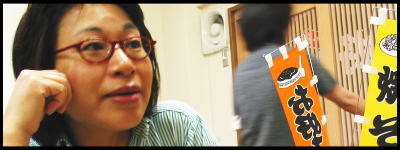
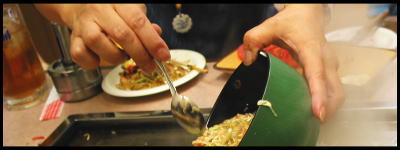
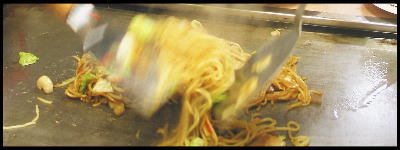
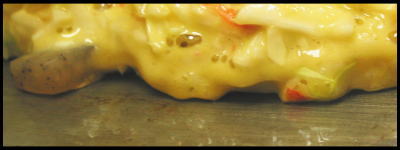
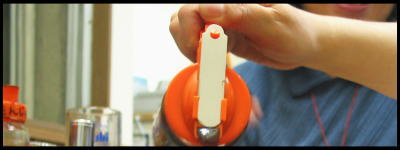
Two weekends ago we went to a newly opened
okonomiyaki restaurant in our neighborhood with Karen's
friend Takada-san and her friend Tajima-san.
Okonomiyaki is kind of like a savoury omelette with
mixed vegetables and seafood. You can often
buy it from street vendors near the major
stations or at festivals, but if you want
the really good stuff you have to go to a
restaurant and make it yourself on the table-griddle.
There are many different kinds of restaurants
here where the diners cook the food themselves
at the table (e.g., shabushabu, yakiniku). In fact, one of my ongoing jokes to my
Japanese friends is 'Why is Japanese restaurant
food so expensive when it's either served
to you raw our else you have to cook it yourself?'
It was a nice treat for us to be taken
to
this restaurant because we probably
wouldn't
have gone on our own. We wouldn't have
been
able to read the menu, and even if
we could,
we wouldn't know how to make the food
at
the table anyway.
I asked Karen afterwards if she thought
that
this kind of cook-it-at-the-table-yourself
restaurant would do well back in Canada.
She said "No, because you know
that
some goof would end up getting drunk
and
putting his hand on the griddle, and
then
would probably end up suing you."
True enough, I guess.
----------------------------------
On Sunday I told you about how Jack and I
went to the local high school's sports day
event and were fascinated (at least I was fascinated, Jack looked bored) by the
boys 'gymnastics.' This seemed to generate
a lot of interest, so I thought I'd show
you a few pictures.
This picture shows how Japanese kids
learn
about corporate structure.
As I said, all of the teams performed
the
same routine at the same time.
These last four pictures were taken over
the shoulders of the judging panel. Remember
how I said that each step in the formation
of these 'gymnastic human constructions'
was synchronized between teams using a whistle?
Well, imagine these pictures being taken
after the whistle blast -- blow once, blow
twice! Next formation: blow once, blow twice!
  05.26.02 05.26.02
click to enlarge
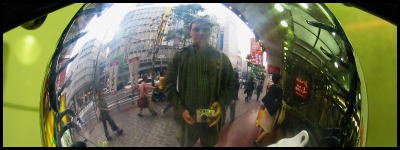
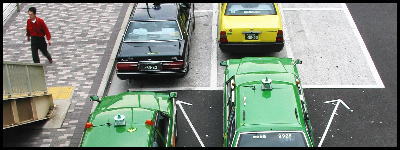
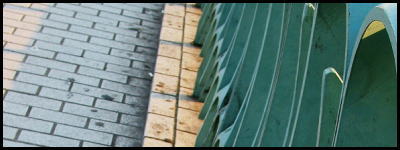
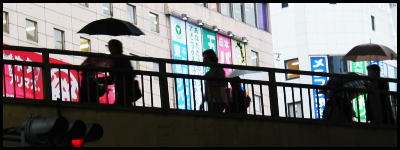
This afternoon at our local junior high shool
there was a 'sports day' event. Jack and
I went to check it out and to take some pictures
because Karen was out at some local flea
markets.
We only caught the tail end of the event,
the last two segments: boys cheerleader-like
group gymnastics and girls relay racing.
The gymnastics was definitely the most interesting
spectacle.
What they did was closer to cheerleading
than gymnastics actually. Each team consisted
of about ten boys around 13 years of age.
They all wore blue shorts and white T-shirts,
but each team had its own coloured head bands
(red, blue, yellow, etc.). Their demonstration
lasted for about twenty minutes and consisted
of them performing a series of group maneuvers
most of which involved some sort of human
pyramid type thing. They were actually quite
impressive, getting three of four people
high, or doing strange balancing tricks and
then collapsing into gracefully controlled
piles.
It was a competition. There was a long row
of judges made up of various high school
teachers and dignitaries. The interesting
thing about it all is how it contrasted with
US-style academic competition, particularly
cheerleading competitions. Essentially, it
emphasized group cooperation and indirect
competition rather than personal competition
and individual aggrandizement like similar
events in the West do.
You all know how American (really I should
say 'Western') group competitions go. Each
team tries to come up with the most difficult
and impressive routine that it can, and then
one by one, each after the other, they perform
their routine in front of a panel of judges.
This is all, of course, highly competitive
and highly individualistic. That's the point
really.
In contrast, these Japanese teams all performed
the exact same routine. It had obviously
been given to them a long time in advance,
and a big part of the scoring (I believe)
had to do with how precisely they could perform
the routine. Not only did they have the same
routine, all of the teams performed it simultaneously.
They were all spread about the school yard
and they had to perform the routine in sync.
There were musical cues (like whistles and
drum beats) for every move.
So, for example, each team would begin a
particular segment by standing shoulder to
shoulder in a line. A whistle would blow
and the boys on either end of the line would
all turn inwards and kneel down. The whistle
would blow again and the boys second from
the end would take two steps up unto the
shoulders of the kneeling boys, and on and
on like this through a variety of human-body
constructions.
It was a celebration of cooperation and synchronization.
It was a competition, but no one competed
individually -- everybody competed with each
other all at the same time.
It's fairly well known that the typical stereotype
of Japanese people is that they're group
thinkers and unconfrontational (read uncompetitive)
and, like most stereotypes, there is some
truth to this. What I found interesting in
all of this, however, was the way in which
this sports day event served to illustrate
how educational programs both shape the national
character and are in turn shaped by that
character.
  05.23.02 05.23.02
click to enlarge
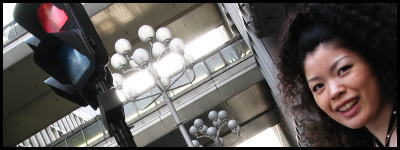
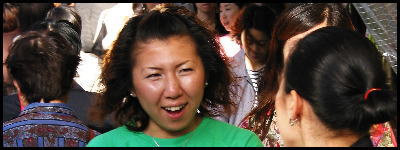
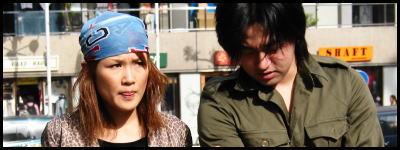
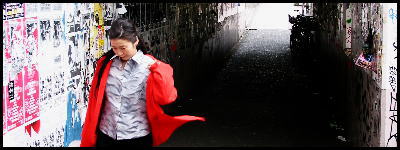
Have you seen the cutest laptop ever? (via memepool).
-------------------------------
Last Sunday, May 19th, I told you that my
friend Makis and I were considering starting
a business here in Japan. I asked you for
some suggestions. I wanted to know what you
thought would be a good thing to import from
the West (both real products/services and
business ideas in general).
I got a lot of interesting suggestions, from
French-Canadian poutine (french fries, cheese
curds, and gravy) to 'bowling culture.'
I loved hearing your suggestions so much
that I'd like to keep this discussion open
for a bit longer.
So, tell me, what do you think would be a
great product or service to bring to Japan?
  05.21.02 05.21.02
click to enlarge

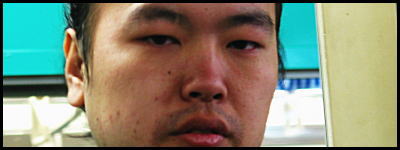
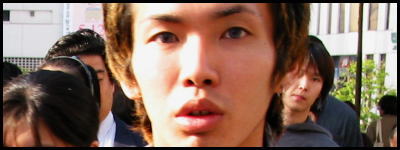

The other day I came across the work of a
great news photographer from the 1930s: Arthur
Fellig, also known as Weegee.
I try to approach my own photography from
a documentary point of view. I suppose that
shows my anthropological and archaeological
background.
I often get a little thrill while looking
at old photographs of mundane people
performing
everyday actions because they seem,
as a
result of age, to be imbued with a
special
significance. I suppose they seem significant
because they represent something that
was
lost, be it a fleeting moment in time
or
the frame of mind of a person living
in a
different era.
I look at people in old photographs
and find
myself asking the same questions that
I've
often heard people ask themselves while
watching
a baby play: What's going through their
mind
right now? What does the world seem
like
to them?
I suppose the heart of the issue is that
photographs are little stolen moments in
time and by their very nature they serve
to remind us of our own mortality.
|
|
|
 |


18 comments so far